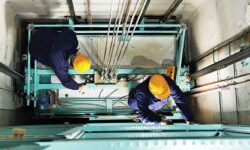Technology in Safety
Technology in Safety in Construction: Building Smarter, Safer Sites
Construction has always been one of the most dangerous industries in the world. Every day, workers face risks—from heavy machinery to working at heights, from electrical hazards to moving vehicles on-site. Traditionally, safety measures relied on rules, personal protective equipment (PPE), and human vigilance. While these are still crucial, the landscape of construction safety is rapidly changing, thanks to technology.
From wearable devices to AI-driven monitoring, technology in construction safety is transforming how we prevent accidents, respond to emergencies, and create a culture where safety is embedded in every action.
In this blog, we will explore the latest technologies improving safety on construction sites, how they are implemented, real-world examples, challenges, and the future of digital safety solutions.
Technology is a Game-Changer for Construction Safety
Imagine a construction site with hundreds of workers. One mistake—a misstep, a missed hazard—can cause serious injury or death. Technology addresses these challenges in ways traditional methods cannot:
- Real-Time Hazard Monitoring: Sensors and smart devices detect unsafe conditions instantly.
- Predictive Safety Analysis: AI analyzes patterns and predicts potential accidents before they happen.
- Automation of Risky Tasks: Drones, robots, and automated machinery can perform dangerous tasks, reducing human exposure.
- Enhanced Communication: Digital tools ensure that warnings, updates, and safety instructions reach everyone quickly.
Safer workers, faster response times, and a stronger safety culture

Types of Technology Improving Construction Safety
1. Wearable Safety Devices
Wearables have moved beyond fitness trackers. In construction, they monitor worker location, movement, vital signs, and fatigue levels.
Examples:
- Smart helmets with sensors detect impacts or falling objects.
- Vests with GPS track worker location and can trigger alerts if someone enters a hazardous zone.
- Wristbands monitor heart rate and fatigue, signaling breaks when necessary.
Impact: Real-time monitoring reduces accidents and ensures workers are accounted for during emergencies.

2. Internet of Things (IoT) for Construction Safety
IoT devices connect equipment, sensors, and workers to a centralized digital platform.
- Sensors on cranes and machinery alert supervisors if load limits are exceeded.
- Environmental sensors monitor temperature, dust, and gas levels in real time.
- Connected sites allow managers to track PPE compliance, worker movement, and equipment status.
IoT makes construction sites smarter, safer, and more responsive to hazards.

3. Drones and Robotics
Drones and robots are revolutionizing inspections and high-risk tasks.
- Drones can survey high-rise projects, reducing the need for workers to climb scaffolds.
- Robots can handle hazardous materials or perform repetitive tasks in dangerous environments.
Case Example: A bridge construction project used drones for inspections, identifying structural risks 30% faster than traditional methods while keeping inspectors safe.

Case Studies: Technology Transforming Construction Safety
Case Study 1: High-Rise Building Project Using Wearables
A skyscraper project equipped workers with smart helmets and vests. Within six months:
- Reported near misses dropped 25%.
- Supervisors could locate workers instantly during emergencies.
- Workers felt more confident and aware of hazards.
Case Study 2: Bridge Construction with Drones and AI
Drones surveyed the bridge site weekly, while AI analyzed structural stress and worker behavior. The result:
- Inspections completed 40% faster.
- Hazard alerts were sent automatically, reducing manual oversight.
- The project reported zero serious accidents over the first year.
Benefits of Technology in Construction Safety
- Proactive Hazard Management: Prevent accidents before they happen.
- Reduced Human Error: Automated alerts and monitoring limit risky decisions.
- Enhanced Training: VR/AR provides realistic, safe training environments.
- Better Data and Insights: Digital tools track trends, compliance, and improvement areas.
- Stronger Safety Culture: Technology reinforces a culture where safety is a shared priority.
Investing in safety technology is not just about compliance—it’s about protecting lives and improving productivity.
The Future of Construction Safety Technology
The future is exciting:
- AI-Powered Safety Supervisors: Autonomous systems monitoring site activity in real-time.
- Robotics in Dangerous Tasks: Robots handling demolition, high-altitude work, or hazardous material.
- Smart PPE: Helmets that track location, heart rate, and environmental hazards.
- Blockchain for Safety Compliance: Immutable safety records for regulatory compliance.
Ultimately, technology and human vigilance will work hand in hand to make construction safer than ever before.



